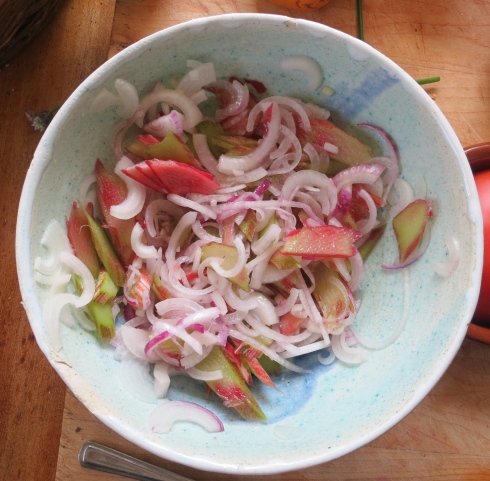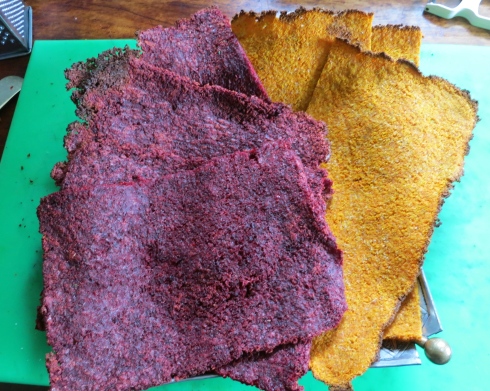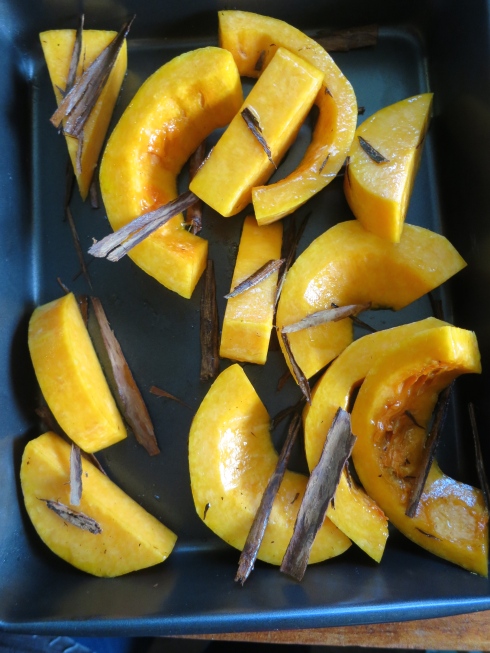
The garden has speeded up big time in the past few weeks. The rise in temperature and some sunshine had all the little seedlings that were at the ‘Will I or Won’t I” live or die stage zoom into action and grow like mad. Suddenly the glass house wasn’t big enough to hold everything. There has been a frenzied potting up and transplanting out session and it’s looking good. Everything is thriving with the sunshine and rain treatment.
Taking into consideration that everything is a few weeks behind with the cold start there’s still a bit of a gap on the eating front. We have spinach and chard again in the tunnels and lots of young herbs in the garden but apart from that and the thriving clump of rhubarb it’s all potential. Potential beans, peas, spuds, fennel, kales etc., all settling in to their newly made beds outside.
The rhubarb is looking great as usual. It’s obviously happy and grows prolifically. The trouble is that apart from the initial excitement at a rhubarb tart or crumble it’s uses are quite limited. I do make a rhubarb and ginger jam which is delicious but with so much else to do jam making isn’t the top of the list.
I decided to play around and put the rhubarb in a salad. I googled for recipes but most called for roasted rhubarb, which might be delicious but not the texture I was looking for in a salad so I decided to try a light pickling and the result was very good, lovely sweet, sour and crispy and excellent together with beetroots, quinoa and orange.
Here’s the recipe, and I will be carting bunches of our rhubarb to the shop so if you fancy trying it without cooking pop in and pick some up
Beetroot , Rhubarb and Quinoa Salad
2-3 beetroots
1 red onion
2 stems rhubarb
1 orange
150g quinoa
2 tbs white balsamic vinegar
1dsp caster sugar
a bunch of mint – chopped
100mls olive oil
100g fresh goats cheese or feta – optional
Cook the beetroots. Give them a wash and tidy up the top where the greenery was then either rub them with olive oil and put in an oven tray and cover with silver foil and bake them for I hour to one hour and a half (180c) or put them in a saucepan and cover with water and simmer covered with a lid for 25=40 minutes. The cooking time will depend on the size of the beetroot. Test whether the beetroots are cooked by piercing with a small sharp knife. If it goes in with no resistance, the beetroot is cooked.
Measure the quinoa and water into a small saucepan. Add a little salt and bring to the boil then reduce the heat to simmer. Cover with a tight fitting lid and cook for 12-15 minutes, until all the water has been absorbed. Tip the quinoa into a large bowl and leave to cool.
Peel the red onion and slice finely. Sprinkle over a little salt and rub into the onion. The rings will fall apart.
Wash the rhubarb then slice , on the diagonal into skinny pieces.
Put the vinegar, sugar and a good pinch of salt into a bowl and mix until dissolved. Stir in the onion and rhubarb and put aside for at least 15 minutes.

Peel the cooked beetroots and dice into equal sized cubes.
Peel the orange with a sharp knife to remove all the skin and pith then remove each segment of orange with a sharp knife by cutting each side of the segment, leaving the skin behind. Do this over the onion and rhubarb to reserve any juice.
Fluff the quinoa up with a fork, then add the beetroot, chopped mint and orange pieces. Lift the onion and rhubarb out of the bowl leaving the vinegar mix behind and add to the quinoa. Whisk the olive oil into the vinegar then pour over the salad. Quickly toss everything together , check the seasoning – it may need a little more salt.

Serve with fresh goats cheese or feta crumbled on top or without if you want to keep it vegan and dairy free.









